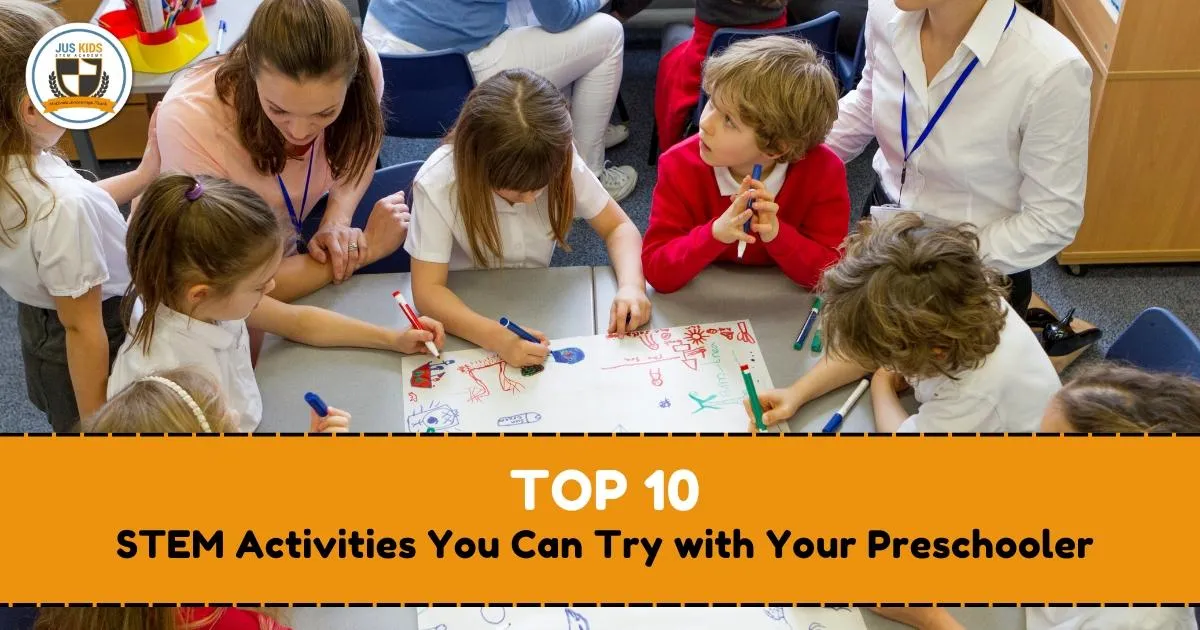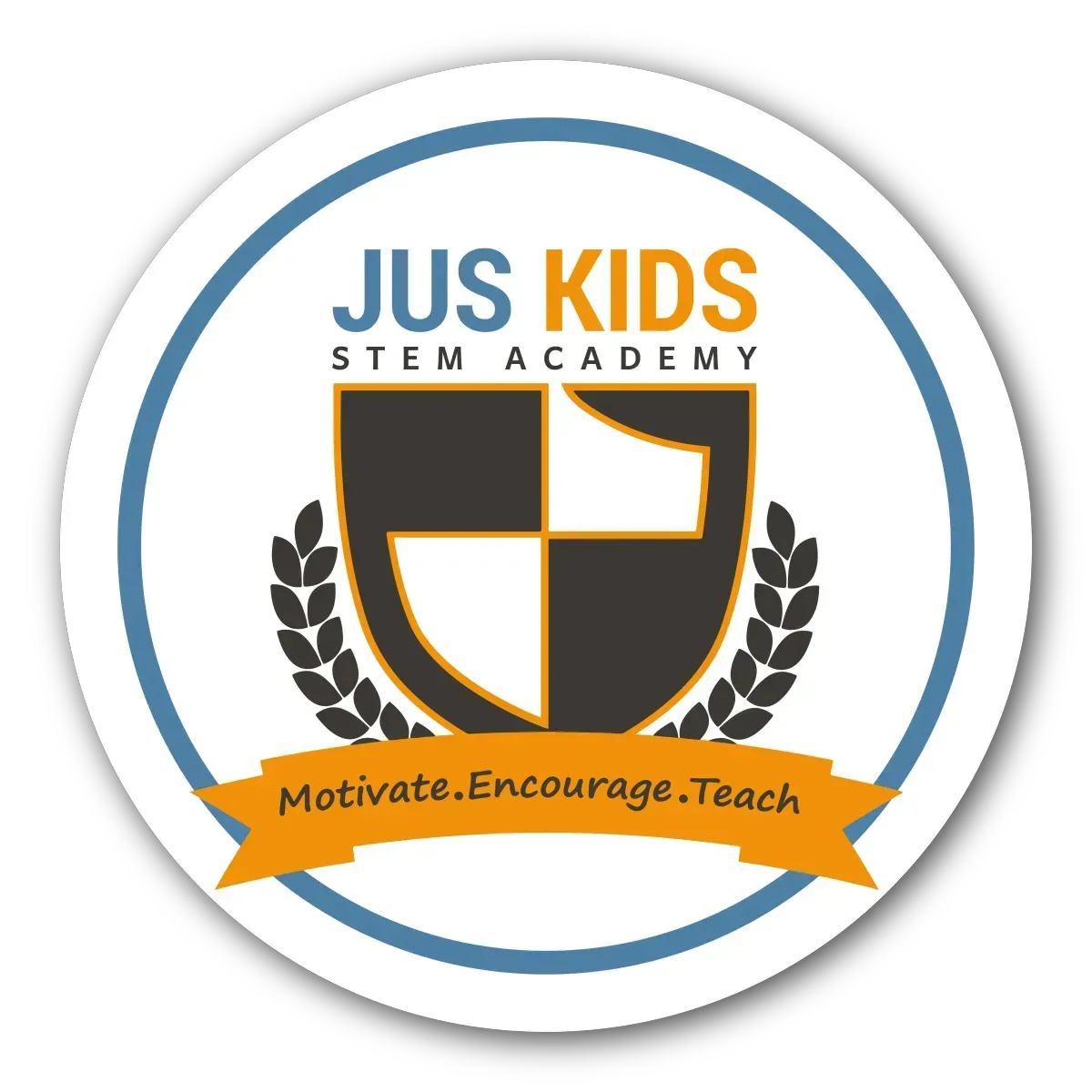
Top 10 STEM Activities for Toddlers You Can Try Today
Ever wondered why your toddler keeps stacking blocks into wild towers or pouring water from one cup to another for no reason? That’s not just random play, it’s science in action.
We once had a parent at Jus Kids Academy who was frustrated. Her 3-year-old daughter kept taking apart every toy she owned. “She’s just destroying everything,” the mom sighed. But after we introduced her to structured STEM activities for toddlers, something clicked. That same curious little girl built her rocket out of blocks and explained gravity with a giggle. The problem wasn’t the behavior. It was the need for a challenge.
Curiosity isn’t chaos, it’s a clue.
And if we tap into it early enough, we can fuel a love for learning that lasts a lifetime. That’s exactly what the activities below are designed to do. Whether you’re at home or school, these STEM activities for preschoolers are easy to set up, fun to explore, and just messy enough to feel like real science.
What Are STEM Activities?
STEM activities are fun, hands-on projects that help kids explore Science, Technology, Engineering, and Math. They encourage curiosity, creativity, and problem-solving by letting children build, experiment, and discover how things work around them.
From stacking blocks to mixing colors, these activities turn playtime into a smart adventure that makes learning exciting and real for young minds.
1. Sink or Float Experiments
Fill a tub with water. Hand your toddler random items, such as a spoon, sponge, rock, and rubber duck. Ask them: “Do you think this will sink or float?”
This activity isn’t just fun, it lays the groundwork for basic scientific thinking.
Why it works:
Introduces scientific prediction and observation
Encourages hands-on exploration
Uses items you already have at home
Pro Tip: At Jus Kids Academy, we grow curious kids through challenges like this that feel like play but build real-life problem-solving.
2. Marshmallow Engineering
Grab toothpicks and marshmallows. Then ask your child to build a house, a bridge, or a rocket ship. You’ll be shocked how seriously they take it. This is more than play. It’s engineering, problem-solving, and spatial thinking rolled into one sweet and sticky experience.
Bonus: It’s a fantastic example of easy STEM challenges that teach structure and balance.
3. Nature Walk and Collection Challenge
Take a walk. Ask your preschooler to find five leaves, three rocks, and two sticks. Back home, you’ll explore size, color, shape, and even symmetry.
Why this rocks (pun intended):
Combines observation with categorization
Gets kids moving and learning
Encourages natural curiosity
This is a simple and impactful example of STEM activities for infants and toddlers that don’t need screens or special materials.
4. Color Mixing with Water and Food Dye
Grab three clear cups. Fill them halfway with water. Add blue, yellow, and red food coloring. Give your toddler a plastic spoon and let them mix colors in a new cup.
Let them predict what happens when they mix red and blue or yellow and blue. Then let them test it.
What they learn:
Primary versus secondary colors
Observation and prediction
Scientific cause and effect
This is one of our favorite STEM activities for preschoolers because it doubles as a mini art class with a scientific twist.
5. Ball Ramp Challenge
Watching a ball roll down a ramp can be exciting for little ones. You can use simple things like cardboard boxes, books, or paper towel tubes to make ramps at home. Then, let your child try different balls, such as ping pong balls, tennis balls, or marbles, to see which one rolls faster or goes farther.
This activity teaches children about how things move. When your child changes the ramp’s height or angle, they learn that steeper ramps make balls go faster. Using different balls helps them understand that size and weight affect how far or fast something moves.
To make it even more fun, use a ruler or tape measure to see which ball goes the farthest. You can record the results by drawing or placing stickers. This simple experiment helps your preschooler learn through play, building early science and math skills.
What they learn:
How gravity pulls objects down
How does changing the ramp affect speed
Comparing the sizes and weights of balls
Measuring and recording results
Pro Tip: We often use this challenge at Jus Kids Academy to introduce toddlers to physics concepts without using big words. We just let them play, question, and test.
6. Magnet Hunt
Give them a simple magnet, like one from the fridge, and let them go on a magnet hunt around the house. What sticks? What doesn’t?
Create a list with two columns: “Magnetic” and “Not Magnetic.”
What makes it so engaging:
Hands-on science
Introduces early classification
Feels like a mystery game that kids love
This simple activity checks every box in the STEM activities for toddlers list. It’s interactive, educational, and lets kids explore independently.
7. Ice Excavation
Freeze small toys like buttons or LEGOs in a bowl of water. Pop the ice out and hand your preschooler some tools such as a spoon, a cup of warm water, or even a spray bottle. Then watch them try to excavate the treasures.
Why this is brilliant:
Teaches about temperature and the change of states
Encourages patience and persistence
Engages tactile and sensory play
Easy STEM activities like this one build grit while introducing basic science without making it feel like a lesson.
8. Build a Bridge with Everyday Items
Hand your child materials like popsicle sticks, playdough, tape, and string. Then give them a challenge: Build a bridge that holds a small toy. It’s a true test of creative problem-solving. And when the bridge collapses? Even better. They’ll try again with something new.
Why this matters:
Builds resilience and design thinking
Reinforces trial and error
Uses items already in your craft drawer
9. Shadow Tracing with Toys
Go outside on a sunny day. Place your toddler’s favorite toys on paper and trace their shadows. Wait an hour and trace again. What changed? Talk about the sun’s movement and how shadows shift.
Why toddlers love it:
Combines creativity with science
Uses their favorite toys
Introduces concepts of time and light
It’s one of the most accessible STEM activities for toddlers, especially for visual and artistic learners.
10. Simple Coding with Arrows
No screens needed. Use arrow cards such as up, down, left, and right. Set a goal like “Get the bear to the pillow,” and have your child lay out the arrows to guide the toy bear through the room. It’s an early form of programming logic, minus the computer.
Why it’s genius:
Introduces sequencing and logic
Encourages planning ahead
Can be adjusted for any skill level
STEM activities for infants and toddlers like this make big concepts feel small and manageable.
Why STEM in Early Childhood Really Matters
Let’s be honest. Most parents want their child to do well in school. But real learning doesn’t start in the classroom. It starts on the floor, in the sandbox, or while playing with spaghetti noodles. These STEM activities for toddlers spark that first “Aha!” moment. They teach your child that questions are good and mistakes are part of the fun.
And the best part? You don’t need fancy equipment, apps, or hours of free time. You just need the willingness to sit down, play, and say, “What do you think will happen if…”
Conclusion: Small Hands, Big Ideas
STEM isn’t just for older kids with lab coats and computers. It starts with blocks, bubbles, ramps, and questions like “What happens if I do this?” When toddlers explore, build, and test things in their everyday world, they’re doing more than playing. They’re learning how to think, solve problems, and enjoy the process.
By adding these STEM activities for toddlers into your routine, you’re giving your child the tools to be curious, creative, and confident.
Ready to nurture your child's love of learning through playful STEM? Visit Jus Kids Academy to see how our hands-on approach helps preschoolers grow smarter and happier every day.
FAQs
1. At what age should I start introducing STEM activities to my child?
You can start introducing simple STEM activities as early as infancy by encouraging exploration through sensory play. For toddlers and preschoolers, activities can become more structured to build on their natural curiosity.
2. How can I keep my toddler interested in STEM activities without losing their attention?
Keep activities short, hands-on, and playful. Follow your child’s lead and be flexible—switch activities if they lose interest and always celebrate their efforts, not just the results.
3. Do I need special equipment or expensive kits to do STEM activities at home?
Not at all. Most effective STEM activities use common household items like water, paper, magnets, or building blocks. Creativity and interaction are more important than costly materials.
4. How do STEM activities help prepare my child for school?
STEM activities promote problem-solving, critical thinking, and creativity—all skills that make learning easier and more enjoyable once formal education begins. They also build confidence in exploring new ideas.
